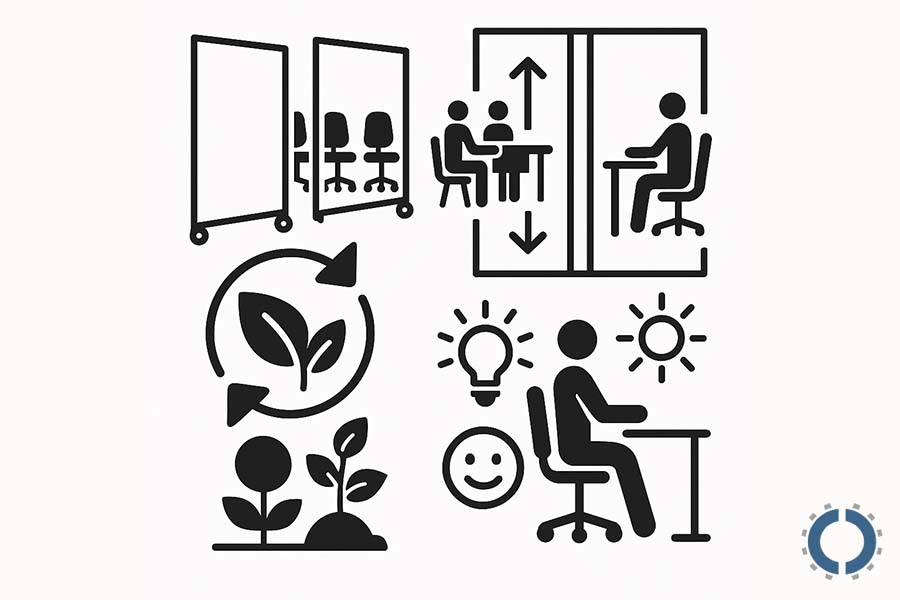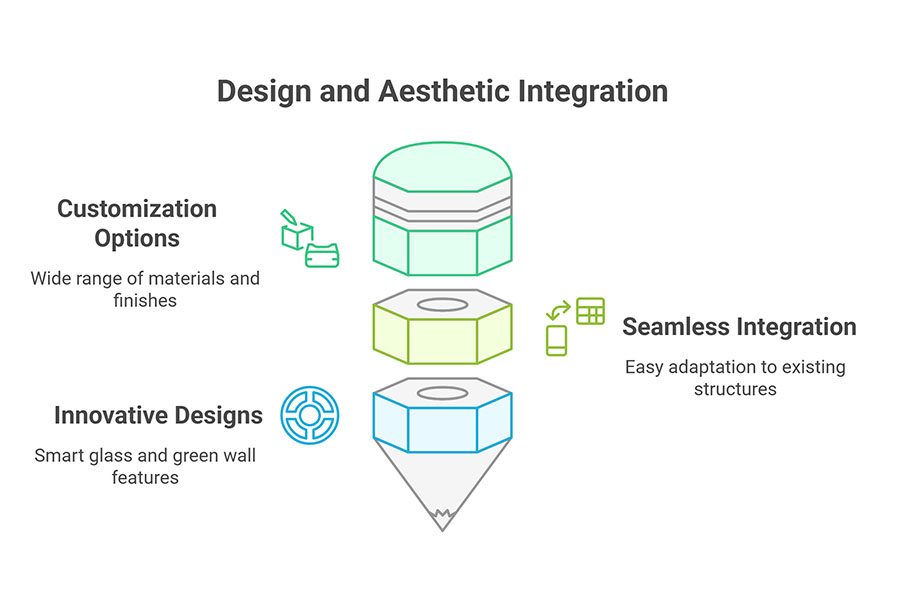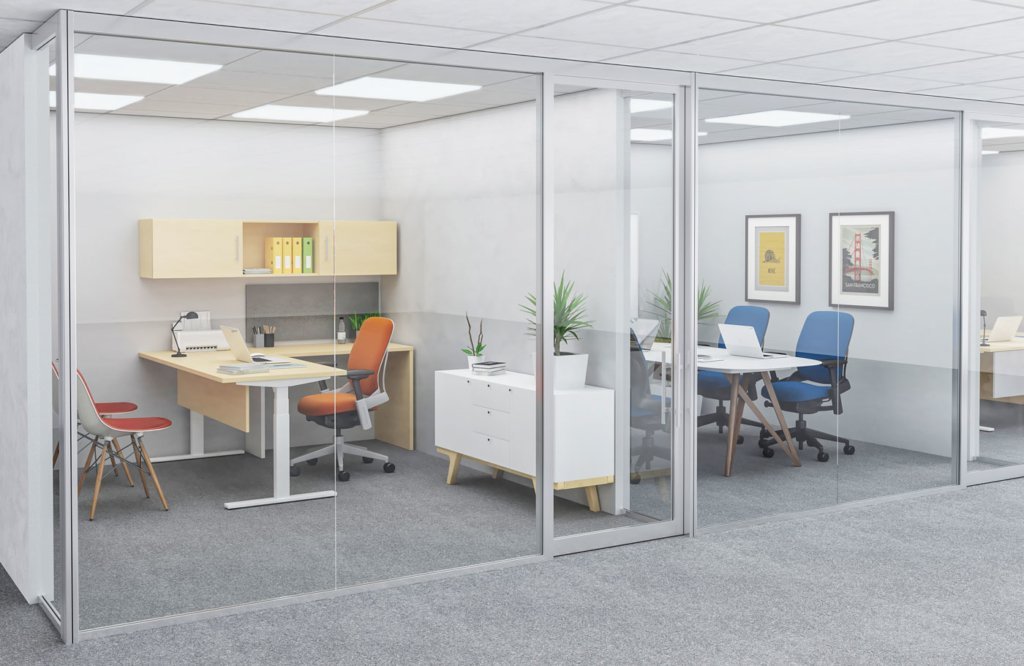Demountable Walls Are Disrupting Office Design In Houston

Today, the era of fixed walls and closed, individual office cubicles is over, and businesses are looking to create a flexible and dynamic space that can meet their needs at any moment.
Therefore, demountable walls were welcomed as an effective and efficient solution, and the business space moved beyond traditional and fixed structures.
Now, the question is how demountable walls are disrupting office design.
Demountable walls disrupt office design by enabling flexible space division, allowing quick reconfiguration for meetings, privacy, or collaboration.
They maximize space efficiency, adapt to changing needs, and support hybrid work models.
This office furniture innovation in Houston enhances office functionality and creates dynamic environments that boost productivity and employee satisfaction.
The demountable walls revolution was in slow motion for close to half a century.
Companies of all sizes are realizing the wisdom in designing spaces that can quickly change to accommodate temporary or permanent staffing fluctuations.
As these companies utilize demountable wall systems to increase competitiveness, they’ve also discovered they can save a bundle on construction and utilities versus conventional drywall.
In this article, we explore how demountable walls will impact the future of office design, a future where employee adaptability and comfort are paramount.
What Took Demountable Walls So Long
The pioneers
When demountable walls entered the market over 40 years ago, many companies looked at the price tag and considered them an exciting concept, but with no real-world application.
Construction costs were relatively low at that time.
Some of the earliest users were the corporate giants with their half-acre multilevel offices that cried out for practical methods of dividing and rearranging space.
Government offices were quick to implement demountable walls for the same reasons.
The broader market
At a time when the term “global market” only applied to a tiny number of industries, the business climate was considerably more static than it is today, with little need for reconfiguring space (a key point in selling demountable walls).
Small and mid-sized companies were reluctant to adopt demountable walls because, at the time, it was more expensive than using drywall, and it required a new thought process in terms of design.
Change happens
Many events over the past couple of decades have contributed to demountable wall systems being viewed as the indispensable office technology they are today.
First, global trade barriers were broken down, and suddenly, businesses were no longer competing with Frank down the street.
Their competition is people they’d never heard of on the other side of the world. Companies were forced to embrace flexibility or go the way of the dinosaurs.
What made the transition to demountable walls even easier was that each evolution of the product was better engineered and affordable.
At the same time, conventional construction costs hit the roof.
How Demountable Walls Are Disrupting Office Design In Houston
1. Flexibility and Adaptability
Today, business owners face constant changes in team structures, work styles, and operational needs, and they must arrange office spaces to accommodate these changes.
Meanwhile, demountable walls, as one of the most innovative design elements, have provided an effective response to this challenge.
- Dynamic Space Utilization: Using demountable walls, workspaces can be transformed in minutes.
This feature allows companies to easily change the layout of the space to suit their needs.
They can also consider the size of the rooms according to the number of team members.
With demountable walls, a space can be used optimally and for different purposes.
This type of flexible use of space maximizes the productivity of the work environment and ensures that no part of the space is wasted.
- Comparison with Traditional Fixed-Wall Designs: In contrast, the traditional design with fixed walls has several limitations, such as a lack of flexibility to business needs.
Also, wasting space with a traditional design reduces efficiency.
When the layout of the space is fixed, employees have to adapt to it, while demountable walls solve this problem and align the work environment with the employees and their goals.
2. Sustainability and Environmental Impact
Today, environmental issues and awareness of them have pushed the design of workspaces to a point where it is no longer possible to remain indifferent to these issues.
Demountable walls play an important role in creating sustainable and environmentally friendly offices.
- Material Efficiency: Demountable walls are usually designed using recyclable materials.
For example, recycled aluminum for frames, FSC-certified wood panels, and Low-E glass can be used to build these demountable walls.
These types of materials not only cause less damage to the environment but also have a longer lifespan, and can be reused if the space is replaced or redesigned.
- Energy Savings: Demountable walls can be significantly effective in optimizing heating, cooling, and ventilation systems.
By dividing the space, only the part being used can be heated or cooled.
Some demountable walls also have thermal insulation and prevent energy loss.
As natural light passes through transparent demountable walls, the need for artificial light is also reduced.
- Waste Reduction: One of the biggest environmental issues in office interior design is waste from renovations and structural changes.
Unlike traditional walls, demountable walls can be installed or moved without the need for demolition.
3. Enhancing Employee Well-being and Productivity
The work environment has a direct impact on employee satisfaction, mental health, and performance.
Business owners know they need to create an environment for employees that supports them psychologically and functionally.
In this regard, demountable walls play an important role in creating such a space.
- Acoustic Control: One of the important reasons for reduced employee concentration and job dissatisfaction is environmental noise.
Some models of demountable walls are equipped with acoustic materials that absorb sound to a great extent.
Therefore, the sound of voice calls, meetings, and team spaces in the environment is greatly reduced.
The result of this sound control is increased concentration, reduced stress, and increased work quality.
- Natural Light Access: Natural light has a direct impact on mood and even mental productivity.
Unlike traditional walls, transparent and translucent demountable walls allow natural light to pass through the entire space.
Therefore, they create a bright and pleasant atmosphere for employees.
- Employee Satisfaction: Flexible and customizable work environments have a direct impact on employee morale and satisfaction.
In changeable spaces with the possibility of personalization, it creates a greater sense of control over the environment for employees and increases their motivation.

4. Weighing the Costs of Demountable Walls
When looking at initial values for a project and comparing standard construction and demountable wall installation, there are several variables to consider.
Depending on the type of demountable wall used, costs can run up to $3.00 per square foot more than standard drywall construction.
However, the cost difference is offset by a few factors.
- Schedule: Demountable wall installation will save you three to four weeks on your construction schedule.
- Potential tax savings over the lease term: Talk to your CPA or CFO, but often, the demountable wall costs can be structured so that tax savings over five years are possible.
- Future reconfigurations: There are significant savings when reconfiguring an office space using demountable walls.
A typical budget to reconfigure space in an office can run around fifteen thousand dollars.
Demountable walls will reduce that by roughly sixty percent.
- Maintenance Costs: Demountable walls have different, and often lower, maintenance costs compared to traditional construction.
Demountable walls are usually made of materials that are scratch-resistant and stain-resistant and do not require structural repairs.
Also, if a section is damaged, only that section is replaced, not the entire wall.
If you wish to change the layout, it can be done without the need for demolition and costly renovations.
- Return on Investment: Investing in demountable walls not only reduces costs in the future but also brings direct and indirect added value to the company.
Demountable walls help maximize existing space, without the need to rent or purchase additional space.
Also, with the ability to quickly transform spaces, one environment can be used for multiple purposes.
5. Considerations for landlords
Standard construction is messy, disruptive, and time-consuming.
It can take several weekends, even for only an office or two.
When using demountable walls, it would be possible to reconfigure in a single weekend.
Without issues like drying time, fumes, and dust from debris, installation is easier.
The likely outcome is fewer, if any, complaints from occupants.
It can mean significant savings for firms that will reconfigure office space more than once or twice every five years.
Additionally, shorter renovation times mean fewer vacancy periods and faster new tenant onboarding.
In competitive rental markets, offering adaptable spaces can be a decisive advantage and attract more valuable tenants.
6. Reshaping Workspaces in Minutes
One of the biggest advantages of demountable walls over dry walls is that they are not just spatial structures, but real-time management tools for organizing workspaces.
In today’s work world, where speed, team collaboration, and rapid response to change are paramount, the ability to rearrange a space in a matter of minutes can make a significant difference in team performance.
Imagine that one morning, you need an open space for a marketing team brainstorming session, but that same afternoon, the same space needs to be converted into small rooms for HR interviews.
In a traditional environment, such a change is either impossible or requires labor, time, and expense.
But with demountable walls, this process takes just a few minutes, without special tools or disruption to the teams’ work.
This instant flexibility not only maximizes space efficiency but also gives organizations a sense of control and agility.
Teams can customize their space based on the needs of the day, the type of project, or even the members’ work ethic.
This is a competitive advantage, especially for organizations with temporary projects or dynamic structures like startups.
In practice, demountable walls allow companies to control space as precisely, quickly, and flexibly as they manage their human or financial resources.
7. Design and Aesthetic Integration

Demountable wall manufacturers are continually upgrading their designs.
What was once a product with limited design flexibility now offers a wide range of finishes and component options.
Having aesthetic options is appealing to companies looking for ways to lower project costs.
Demountable walls allow design options that effectively blend with an open office environment.
It’s a key draw for younger generations of workers.
With new terms like “collaboration areas” and “flex space” in today’s office culture, building products that fit the design rather than limiting design to match the process is a natural choice.
With their high flexibility in design, demountable walls can easily coordinate with a variety of decoration styles and transform an office space from a dry and formal environment into an inspiring and professional space.
Demountable walls are also available in full glass panels or as solid panels, allowing for your desired level of privacy and aesthetic look.
- Customization Options: One of the biggest advantages of demountable walls is the ability to choose from a wide range of materials, colors, and finishes.
This variety includes glass panels, natural or synthetic wood veneers, metal or aluminum veneers, acoustic fabrics, and stain-resistant coatings.
- This variety allows companies to choose walls that perfectly match the brand’s look, organizational colors, and overall feel of the workspace.
- Seamless Integration: Demountable walls are designed to integrate with the existing structure in the office easily.
These walls, with their slim and minimalist frames, adapt to a variety of office furniture in Houston and space decoration and do not require major changes to the floor or other elements of the environment.
- Innovative Designs: Some leading manufacturers of demountable walls have designed systems that are themselves a decorative and attractive element in the space.
For example, smart glass walls with the ability to change from transparent to opaque with a switch and illuminated panels are among these types of demountable walls.
Also, by integrating natural elements, moving green walls can be created in space.
8. Implementation and Practical Considerations
It is true that demountable walls are simple and beautiful in appearance, but to use them properly, you must consider careful planning, proper implementation, and proper maintenance.
- Installation Process: Installing demountable walls is faster, cleaner, and less disruptive than traditional construction.
To install these walls, the steps of initial space assessment, design and selection of wall types, space preparation, and final installation and adjustment must be carried out in order.
The installation time can range from a few hours to a few days, depending on the size of the project.
- Maintenance Tips: Although demountable walls do not require permanent repairs, proper maintenance will ensure their durability, comfort, and appearance over the years.
Regular cleaning of surfaces with a soft cloth and appropriate materials, periodic inspection of rails and hinges, and avoiding impact or severe pressure are some of the precautions you can take to extend the life of demountable walls.
Demountable Walls as a Strategic Tool
In the new era of business, workspace design has become a strategic tool for shaping organizational behavior, culture, and performance.
Demountable walls are not just space dividers, but also a smart architectural language to convey brand messages, reflect organizational values, and optimize work interactions.
Purposeful use of color, material, transparency, and even light in the design of demountable walls can help create workspaces with different moods.
From open and inspiring spaces for creative meetings to quiet and focused environments for individual work, each requires its own environment.
This design variety can impact the user experience and also tangibly increase productivity.
Additionally, companies that use demountable walls can redesign their workspaces depending on the season, project, or changing team structure without the cost or time of traditional construction.
This capability transforms organizations into agile, responsive, and adaptable structures.
Into the Future of Office Space Design
The goal has always been to provide adaptive wall systems while offering an attractive and modern design. With the challenge of maintaining the project completion schedule, demountable walls were hyped as the future of office space design in the ’60s. While they certainly took a long time to catch on, we believe the hype is real.
Factors such as new technologies, flexible working styles, the importance of mental health, and employee productivity have led businesses to seek solutions that are both adaptable, smart, and aesthetically pleasing.
- Technological Advancements: The new generation of demountable walls, utilizing smart technologies, has become an interactive element in space.
Automatic light and sound control, IoT systems for temperature and light regulation, touch screens, and the ability to open and close walls remotely are among the innovative features of demountable walls.
- Trends to Watch: Changes in work styles, especially after the COVID-19 pandemic, have transformed office design.
With demountable walls, multi-purpose spaces increased, and hybrid workspaces became very popular.
Demountable walls, especially with their easy portability and design versatility, play an important role in implementing these trends.
- Hybrid Workspaces: According to the perspective of architects and interior designers, the future of offices is moving towards spaces that have features such as modularity and adjustability, interactivity and intelligence, and environmental compatibility.
These walls also feature customization capabilities for teams and individuals.
According to many experts, flexibility and rapid responsiveness of the space to user needs will be the most important feature of future offices.
Conclusion
As we explained, workspaces are changing rapidly, and demountable walls are considered one of the essential tools of this transformation.
They take the workspace out of its traditional and fixed state and redefine efficiency and creativity by increasing flexibility, aesthetics, optimizing energy consumption, and enhancing employee satisfaction.
Now is the time for businesses to look ahead and embrace modern, scalable solutions instead of using fixed, outdated structures.
Demountable walls are a strategic investment for flexible and sustainable spaces that align with the current and future needs of organizations.
If you’d like to see demountable walls up close, plan a visit to our showroom at 8 Greenway Plaza, Suite 200, Houston, TX 77046.
Contact us beforehand, and we’ll be sure our experts are available to answer your questions.

John Ofield is the owner of Collaborative Office Interiors. Houston’s trusted source for modern and commercial office furniture, office cubicles, demountable walls, office desks and tables, and complete workspace solutions. With more than 40 years of experience, he combines deep product knowledge with hands-on space-planning expertise to create ergonomic, productivity-focused work environments for businesses across Southeast Texas.






